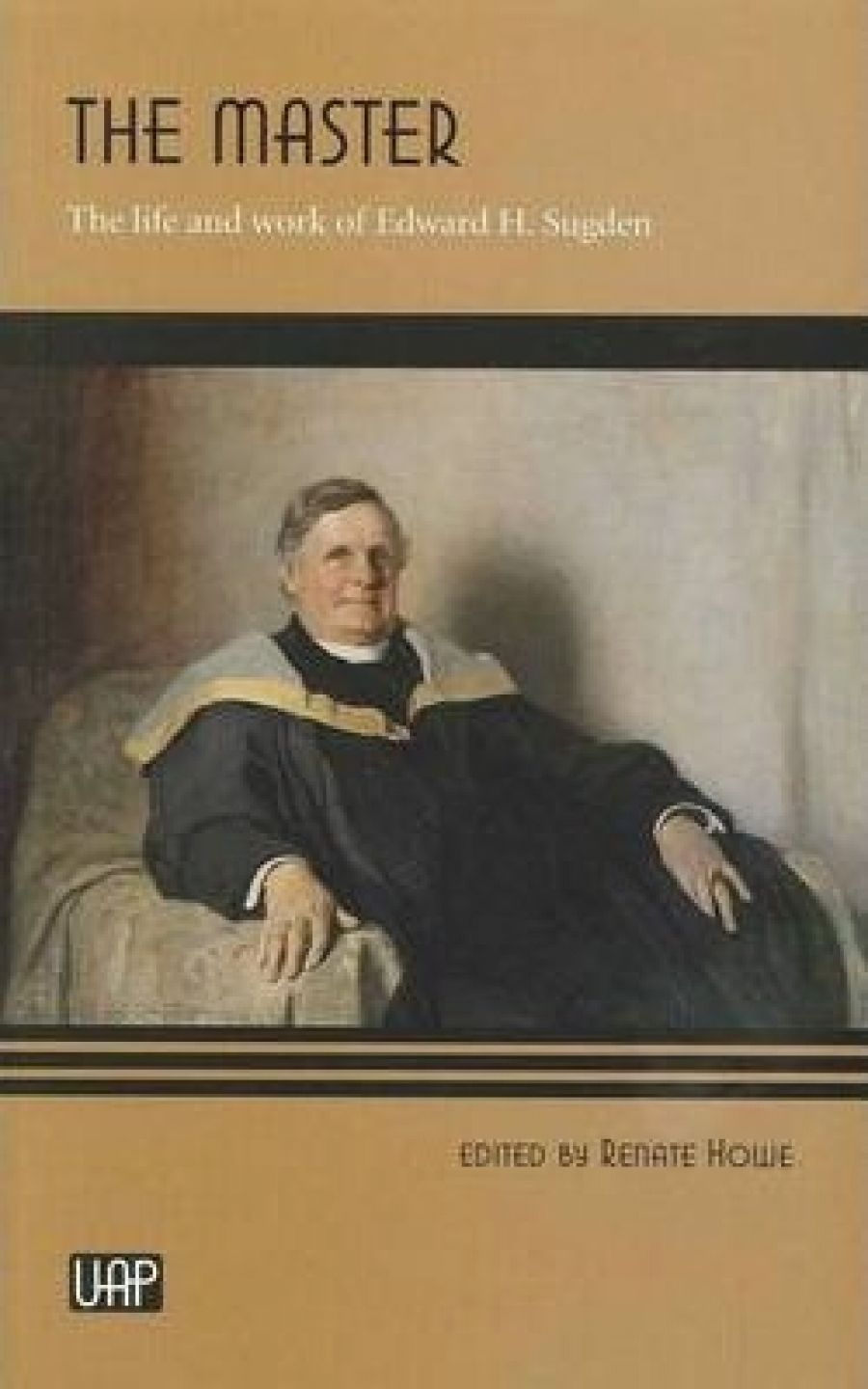
- Free Article: No
- Contents Category: Biography
- Review Article: Yes
- Online Only: No
- Custom Highlight Text:
Edward Sugden was the first master of Melbourne University’s Queen’s College, a position he held for forty years. One needs to provide this identification, because although in his day Sugden was regarded as one of Melbourne’s best-known citizens, his is one of those names that has dropped from view. Along with his contemporaries Alexander Leeper of Trinity College and John MacFarland of Ormond, he contributed to what Wilfrid Prest calls ‘the golden age’ of Melbourne University’s colleges.
- Book 1 Title: The Master
- Book 1 Subtitle: The life and work of Edward H. Sugden
- Book 1 Biblio: Uniting Academic Press $39.95 pb, 279 pp
Sugden was an engaging figure. Alex Tyrrell introduces him as a Methodist moderniser. With a science as well as an Arts degree to his name, Sugden had no difficulty with Darwin and evolution, and, never a literalist when it came to reading biblical texts, was comfortable with the new higher criticism. He was also a populist, in the sense that, as an evangelical, he wanted his preaching or lecturing to be easily accessible; in this he was aided by his gifts as a speaker and performer. At Queen’s College he presided over a relaxed, liberal régime: according to his daughter Mary, ‘he knew when to leave people alone, and he knew when to enter deeply and closely into their lives’.
One of Sugden’s interests that might seem unusual for a clergyman was psychical research. He believed in the reality of ‘mental telegraphy’ or thought transference, denying any supernatural explanation of the phenomenon, and regarding it as a subject for scientific inquiry. But he was not beyond providing entertaining demonstrations of such telegraphy, which he carried off with all the flair of a magician.
There was certainly nothing of the wowser about Sugden. He was by temperament a clubman, and, elected to the élite Beefsteak Club, happily joined in a chorus of the club song, in praise of ‘Love and Song and Wine’; at its next dinner he went one better by himself rendering ‘Simon the Cellarer’. He shocked some of his Methodist brethren by being seen in the dress circle of a theatre, and encouraging amateur theatricals at Queen’s. One assumes, nevertheless, that, although he smoked a pipe, he was a teetotaller, though no contributor to this book explicitly says so; and according to Renate and Brian Howe, he was not in favour of prohibition.
Sugden’s aversion to wowserism was most strikingly evident in his defence of the controversial first Ormond professor of music, G.W.L. Marshall-Hall, who fell foul of the university Establishment because of his bohemianism, and offended religious sensitivities with the publication of a slim volume of mildly erotic verse under the irreverent title Hymns Ancient and Modern (1898). Both Leeper and MacFarland helped mobilise the anti-Marshall-Hall forces, but, as Prest shows, Sugden drew a distinction between the professor’s ‘theological prejudices’ and his capacity and behaviour as a teacher, influenced, it seems, by his own daughter’s experience as a student at the Conservatorium.
Sugden, himself an accomplished musician, appreciated Marshall-Hall’s contribution to the Melbourne musical scene. He had sung in and conducted choirs in England, had some proficiency in the organ and piano, and, as Thérèse Radic points out, has been credited at different times with also playing the violin, viola and cello. He was an avid concert-goer and enjoyed a stint as reviewer for The Argus. He was also an enthusiast for the role of music in children’s education.
The overall image of Sugden emerging from these essays is one of almost relentless cheerfulness. Was there a darker side to the man? His first wife, Mary, a nervous and vulnerable woman, was conscious of his ‘queer and wild’ mood swings and was made aware of her shortcomings; his great-grandson Ken Foster concludes that while Sugden was ‘kind and considerate in great things, it was not always evident in small things’. Sugden’s capable second wife, Ruth, was not, it seems, so intimidated, and could hold her own with him.
The problem with a collection such as this, apart from the inevitable repetitions, is that any critique or evaluation is fleeting or intermittent. Margaret Pawsey convincingly shows that although Sugden supported the higher education of women, they had only a token presence at Queen’s. Indeed, women could not dine in Hall until the 1960s. The Howes, while celebrating Sugden as ‘an exemplar of Methodism at its best’, concede that he was ‘an Edwardian optimist who failed to absorb the significance of the political and economic changes in the post-war world or anticipate the terrible contradictions which were present in science’. This calls for more elucidation.
Renate Howe bills this book as ‘a collective biography’. But of course the necessarily thematic nature of these essays means that there is only a fitful sense of a life unfolding. The last chapter, by the present master, David Runia, on ‘the lasting legacy’, may seem an appropriate conclusion, but is inevitably concerned with the college rather than with the larger context of Sugden’s life and achievement. I feel, too, that the introduction should have at least acknowledged the memoir by his daughter, Mary Florence Sugden (1941), which, while uncritical, has a charm of its own.
In the absence of a biography this collection is nevertheless welcome, but could not some college money have been found to improve its production values? While there are eight pages of colour plates of the chapel’s stained glass windows, the reproduction of the photographs is, with few exceptions, deplorable. Indeed, for some decent pictures one must go back to Mary Florence’s memoir.


Comments powered by CComment